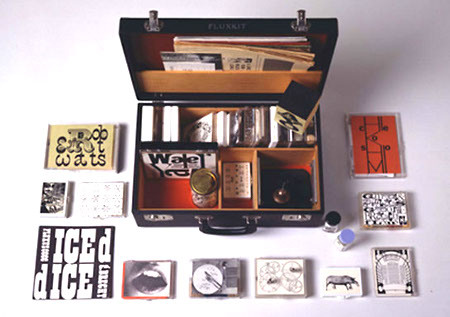Fluxus
Recently I wanted to know more about where Mail Art originated. As it played a big part in my project I felt it would be appropriate to reference the history in some way, either through a particular Mail Art technique or an idea / thought expressed on the back of one of my photographs.
All I knew was, Mail Art was a big phenomena in the 60s and 70s where artists would create pieces of art that would travel the postal system to other artists, friends, or acquaintances. They would either decorate envelopes, letters, and postcards. Using collage, paint, and ink to imagery and text.
Typing Mail Art into google came up with thousands upon thousands of hits. Selecting roughly 50 links I felt I had a wealth of information sitting on my computer. This lead to links on blogs, articles, Wikipedia, art sites, Youtube videos, photographs on Flickr, Pinterest, and even Twitter. I went through each site, some were useless but most were full of relevant and interesting information.
In my search I also came across the term ‘Fluxus’ a Latin word which means flow and flux. Fluxus also described an independent network of artists who blend different disciplines into one another. It also appeared to be where Mail art derived from.
Fluxus was coined by George Maciunas an artist who describes fluxus rather randomly as “a fusion of Spike Jones, gags, games, Vaudeville, Cage and Duchamp.” With the intentions to “purge the world of bourgeois sickness . . . of dead art,” to “promote a revolutionary flood and tide in art, anti-art, promote non art reality . . .” and to “fuse the cadres of cultural, social, and political revolutionaries into a united front and action.”
Held strongly by Dadaist attitude, promoting artistic experimentation mixed with social and political activism. Fluxus members, rather interestingly avoided any limiting art theories, seen as more of an attitude then a movement or style. The artists were simply interested in combining multi disciplines such as everyday objects, images, text and sound. They tried to keep their work simple, concise and laced with humour. They celebrated the banal and the mundane in direct opposition to the subjects traditionally considered worthy of “high” art.
Reading through all the research I could see how Mail Art followed on from fluxus they both shared a lot in common. What more I could see the similarities between fluxus and my own work. Working with image and text I too was lacing humor within my typologies.
With a better understanding of Mail Art history and how it derived from fluxus, I’ve quickly realised how impossible it is to cover all the information which I’ve read. Instead I’ve included some of the key influential figures within fluxus below, to showcase the types of work they were creating and to hopefully understand what fluxus is all about visually.

George Maciunas
Fluxkit
1964
‘Fluxkit’ is a representative selection of artist’s works, encompasses the range of forms in which Fluxus editions were issued: graphical scores for events, interactive boxes and games, journals and films. The originator of the idea of art in a box was Marcel Duchamp with his ‘Boîte-en-valise’. You can see how text and humour was incorporated into the individual art pieces.

Takako Saito
Hat Chess
1990
Famous for her disrupted Chess sets, Fluxus was also about creating games. Manipulating chess sets Saito would alter visual perception removing the chess pieces and replacing them with different vials of spirits, spice, and cheese. “players would be forced to hone non-visual perception, such as the olfactory sense, tactility, and aurality, in order to follow chess rules.” In this 1990’s version Saito has replaced the pieces yet altered the board placing the chess pieces upon a bowler hat.

Joseph Beuys
I like America and America likes me.
1974
“Beuys flew to New York, picked up by an ambulance, and swathed in felt, was transported to a room in the Rene Block Gallery. The room was also occupied by a wild coyote, and for a period of 8 hours a day for the next three days, Beuys spent his time with the coyote in the small room, with little more than a felt blanket and a pile of straw.”

Yoko Ono
‘Cut Piece’
1965
A key figure in the Fluxus movement Yoko Ono’s ‘Cut Piece’ served as a performance, a social event, and a commentary on the role of women in contemporary society. The performance of Cut Piece shows Ono sitting passively on a stage while audience members approach one by one and cut off a piece of her clothing, until she is left in her underwear

